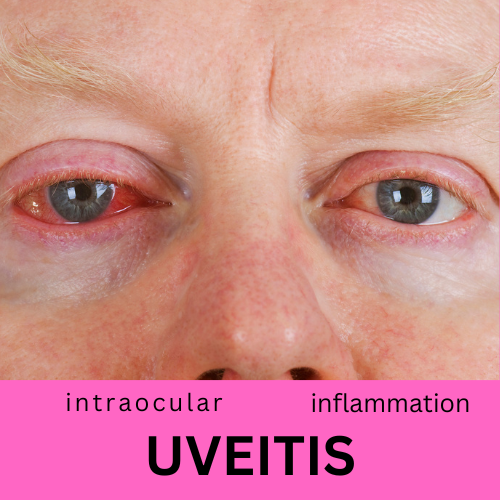What is Uveitis?


Uveitis is a type of intraocular inflammation. It can involve any part of the “uveal” system. The most common symptoms of any uveitis (aka iritis) are pain, redness of the eye and tearing. There are a variety of causes as we discuss here. All types can lead to serious eye problems and vision disturbance.
Uveitis is inflammation of the uvea. Inflammation typically happens when your immune system is fighting an infection. But inflammation can also happen when your immune system attacks healthy tissue in your eye.
It is estimated that 30,000 Americans lose their eyesight every year because of untreated inflammation.
Uveitis can occur in one eye or both eyes and it affects the layer of the eye called the uvea. The uvea is the middle layer of the eye that lies behind the cornea but in front of the retina and consists of three parts—the iris, the ciliary body, and the choroid.
The three parts of the uvea
The iris is the colored part of the eye and it helps regulate the amount of light entering the eye. In the presence of bright light, the muscles surrounding the iris close the pupil to let in less light and when the light is low, the iris opens up the pupil to let in more light.
The ciliary body is behind the iris and it includes a ring-shaped muscle that changes the shape of the lens to focus vision. The ciliary body also produces the clear fluid that fills the eye—aqueous humor. The aqueous humor fluid nourishes the cornea and lens and gives the eye its shape.
The choroid is the vascular layer or blood flow section of the eye and it also contains connective tissue. The choroid provides oxygen and nourishment to the outer layers of the retina.
Causes of uveitis
In up to one-third of all cases of uveitis, the cause is unknown. An injury to the eye, a viral or bacterial infection, or an underlying disease may cause inflammation.
Some additional causes include:
- Cytomegalovirus
- Histoplasmosis
- Reactive arthritis
- Shingles
- Syphilis
- Toxoplasmosis
Sometimes the cause is an autoimmune disease such as:
- Lupus
- Multiple sclerosis
- Psoriasis
- Rheumatoid arthritis
- Sarcoidosis
- Ulcerative colitis
Types of uveitis
There are four types of inflammation depend on the area of the eye that is inflamed.
Anterior
This type of uveitis affects the front of the eye. It mainly affects the area around the eye’s iris. Anterior uveitis is the most common kind of uveitis in children and adults making up 30–90% of all uveitis. It usually comes on suddenly and causes eye pain, blurred vision, light sensitivity, and redness.
Intermediate
This is the least common type of uveitis and it causes swelling of the ciliary body. Symptoms can last for weeks to years and go through cycles of getting better and then worse. Symptoms include floaters and blurry vision. It is not usually associated with pain.
Posterior Uveitis
If the inflammation of the choroid and it often involves the retina and optic nerve. and optic nerve. It is also known as choroiditis or retinitis. The optic nerve is the path that carries images from the retina to the brain. This type of uveitis is typically chronic and can last weeks to years. Posterior uveitis can cause vision loss. This type of uveitis can only be detected during an eye examination.
Panuveitis
Is inflammation that affects the entire uvea (iris, ciliary body, and choroid). People with panuveitis may be more likely to experience vision loss. Symptoms include floaters, blurred vision, or loss of vision.
A serious eye disorder
If not treated, uveitis can lead to severe eye problems, including blindness. Untreated uveitis is one of the leading causes of blindness among working-age adults. Uveitis can also lead to cataracts, glaucoma, damage to the optic nerve, and detachment of the retina.
How is uveitis diagnosed?
Your eye doctor will check for uveitis as part of a dilated eye exam. Blood tests and x-rays may be used to determine if an underlying systemic disease is causing the uveitis.
Treatments for anterior uveitis include:
- Eye drops or ointments that reduce inflammation (steroids)
- Eye drops that lower eye pressure
- Dilating eye drops to reduce pain and swelling
- Antibiotics or antiviral medications, if the uveitis is caused by a bacterial, viral or fungal infection
Treatment options for intermediate, posterior and panuveitis include:
- Antibiotics or antiviral medications, if the uveitis is caused by a bacterial, viral or fungal infection
- Steroids by injection, pill, or intravenous route
- A steroid implant that time-releases the drug into the eye
The goal is to treat the inflammation. After the inflammation is reduced, regular eye exams are recommended to monitor the situation and prevent damage and loss of vision.
Gregory Scimeca, M.D.
Ophthalmologist and Medical Director
The Eye Professionals
Our Locations
